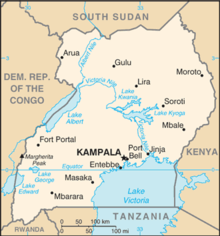User:Scarlson0921/sandbox
| This article was the subject of an educational assignment. Further details were available on the "Education Program:Drake University/Global Youth Studies (Spring 2013)" page, which is now unavailable on the wiki. |
That will result in the following banner (which lets other editors know that you're working on it):
Here is my rough draft of my Youth in Uganda page. I was having trouble finding what the youth recreation life was like in Uganda so I decided to switch that category to Rural vs. Urban life. I chose this subject because through my research, it seems that the rural areas and urban life are vastly different and can affect youth's lives in different ways. I still have a lot to research about these differences though.
Uganda has the youngest population in the world, with 77% of its population is under 30 years of age.[1] There are 7,310,386 youth from the ages of 15-24 years of age living in Uganda.[2]. Youth is a socially constructed intermediary phase that stands between childhood and adulthood.[3] Generally youth can be defined as the period of age between 15 and 24 years old. This page focuses on the life of youth living in Uganda.

Demographics[edit]
The male to female ratio is 100.2 males per 100 females.[4] Life expectancy at birth for males is 42.59 and 44.49 for females.[5] Ugandan youth experience different lifestyles depending on if they live in a rural or urban area. Many youth decide to migrate from the rural areas to the urban areas based on factors that include kinship ties and friendship ties, rural incomes, role of rural education, and the rural social system. [6]
Education[edit]
Uganda established Makere University, its first private university in 1988 and a second public university in 1989. In the early 1990s, Uganda introduced private sponsorship into the public universities.[7] By 2005, there were 27 universities in Uganda and of which 80% were private institutions.[8] The youth literacy rates between 2005 and 2010 were 90% for males and 85% for females.[9] Only students who have successfully completed “A” levels and passed their Uganda Advanced Certification of Education are eligible to enter postsecondary institutions. [10] There are three types of publicly supported institutions in Uganda. They consist of autonomous institutions, institutions run by the Ministry of Education, and institutes administered by the Public Service Commission.

Employment[edit]
The unemployment rate for young people ages 15-24 is 83%. [11] This rate is even higher for those who have formal degrees and live in the urban area.[12] This is due to the disconnect between the degree achieved and the vocational skills needed for the jobs that are in demand for workers. Informal sector work accounts for the majority of young workers in Uganda.[13] 3.2% of youth work for waged employment, 90.9% work for informal employment, and 5.8% of the Ugandan youth are self-employed.[14]
Health[edit]
Age at sexual debut within this community in 2000 was reported at 16.7 years for young women and 18.2 years for young men, while the median age at marriage was 19.5 years for young women and 24 years for men. Information on sexual and reproductive health for young people comes from a variety of sources including parents, paternal aunts (ssenga), uncles (kojja), older brothers and sisters, peers, radio and newspapers. When asked if they had knowledge about HIV, 38% of males ages 15-19 said yes and 31% of females in the same age range said yes.[15] When asked at what age people should become sexually active, all participants across all data collection methods stated that the ideal age is between 18 and 20 years. When asked at what age people actually do start to have sex the answers ranged from 4 to 16 years, but all young people believed this was too early.
References[edit]
- ^ http://www.populationaction.org/oldmedia/SOTC_Uganda.pdf
- ^ http://www.urbanministry.org/wiki/ugandan-youth-statistics
- ^ Furlong, Andy. 2013. Youth Studies: An Introduction. Routledge: New York.
- ^ http://www.urbanministry.org/wiki/ugandan-youth-statistics
- ^ http://www.urbanministry.org/wiki/ugandan-youth-statistics
- ^ Byerlee, D. 1974. ‘Rural–urban migration in Africa: theory, policy and research implications’, International Migration Review 8, 4:543–66
- ^ Bisaso, R. (2010). Organisational responses to public sector reforms in higher education in Uganda: a case study of Makerere University. Journal Of Higher Education Policy & Management, 32(4), 343-351. doi:10.1080/1360080X.2010.491108
- ^ National Council for Higher Education. (2006). The state of higher education in Uganda. Kampala: National Council for Higher Education, Ministry of Education & Sports.
- ^ http://www.unicef.org/infobycountry/uganda_statistics.html
- ^ http://www.schoolguideuganda.com/education-information/higher-education-in-uganda.php
- ^ World Bank. 2008. African Development Indicators 2008/2009. Washington, DC: World Bank
- ^ http://www.populationaction.org/oldmedia/SOTC_Uganda.pdf
- ^ Garcia, Marito. 2008. Directions in Development- Human Development. World Bank
- ^ Garcia, Marito. 2008. Directions in Development- Human Development. World Bank
- ^ http://www.unicef.org/infobycountry/uganda_statistics.html

